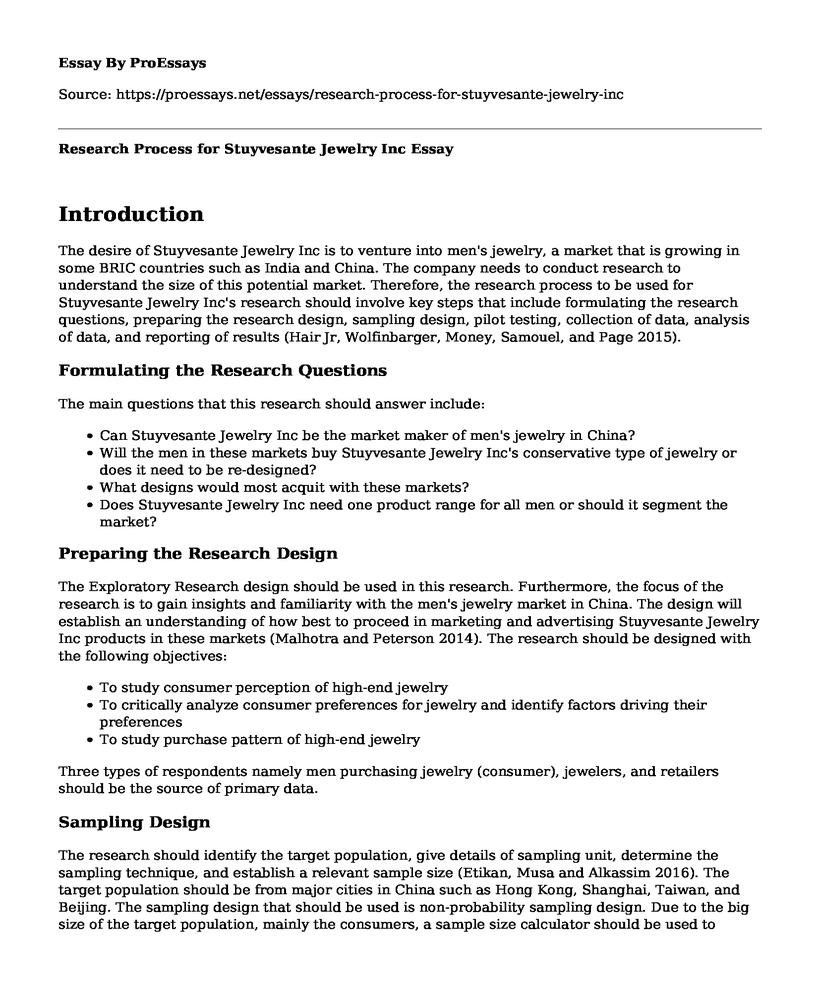Introduction
The desire of Stuyvesante Jewelry Inc is to venture into men's jewelry, a market that is growing in some BRIC countries such as India and China. The company needs to conduct research to understand the size of this potential market. Therefore, the research process to be used for Stuyvesante Jewelry Inc's research should involve key steps that include formulating the research questions, preparing the research design, sampling design, pilot testing, collection of data, analysis of data, and reporting of results (Hair Jr, Wolfinbarger, Money, Samouel, and Page 2015).
Formulating the Research Questions
The main questions that this research should answer include:
- Can Stuyvesante Jewelry Inc be the market maker of men's jewelry in China?
- Will the men in these markets buy Stuyvesante Jewelry Inc's conservative type of jewelry or does it need to be re-designed?
- What designs would most acquit with these markets?
- Does Stuyvesante Jewelry Inc need one product range for all men or should it segment the market?
Preparing the Research Design
The Exploratory Research design should be used in this research. Furthermore, the focus of the research is to gain insights and familiarity with the men's jewelry market in China. The design will establish an understanding of how best to proceed in marketing and advertising Stuyvesante Jewelry Inc products in these markets (Malhotra and Peterson 2014). The research should be designed with the following objectives:
- To study consumer perception of high-end jewelry
- To critically analyze consumer preferences for jewelry and identify factors driving their preferences
- To study purchase pattern of high-end jewelry
Three types of respondents namely men purchasing jewelry (consumer), jewelers, and retailers should be the source of primary data.
Sampling Design
The research should identify the target population, give details of sampling unit, determine the sampling technique, and establish a relevant sample size (Etikan, Musa and Alkassim 2016). The target population should be from major cities in China such as Hong Kong, Shanghai, Taiwan, and Beijing. The sampling design that should be used is non-probability sampling design. Due to the big size of the target population, mainly the consumers, a sample size calculator should be used to compute the sample size to be drawn from the population to have survey results that can be projected onto the target population. The following formula should be used to arrive at an estimate of sample size for the consumer survey.
n= NZ2 (pq)/NT2 + Z2 (pq) (Bryman and Bell 2015)
Where,
n = adjusted sample size
Z = Level of confidence = 1.96 (for 95% confidence level)
T = allowable tolerance of variation = 0.025
N = population size
p = probability of occurring the event = 75%
q = probability of non-occurring the event = 25%
Pilot Testing
A pilot study of approximately 1,000 consumers should be conducted initially to test the relevance and suitability of the questionnaire. The pilot will enable refining of the questionnaire by dropping some questions and adding others for the final study.
Data Collection
Primary data should be conducted from the following respondents of Hong Kong, Shanghai, Taiwan, and Beijing cities:
- Men purchasing jewelry
- Jewelers
- Retailers
The data collection instruments that should be used include interviews and a structured questionnaire with both close-ended and open-ended questions that capture data on the consumer buying behavior.
Data Analysis
The data gathered through questionnaires of consumer survey should be entered in SPSS, and the data to be analyzed using statistical tools in SPSS (Sekaran and Bougie 2016). The statistical tools that should be used are the Chi-Square tests, ANOVA, and Spearman's correlations.
Reporting Results
The research should use non-textual features such as figures and table to report results. The results should state the findings without interpretation or bias, and should be arranged in a logical sequence (Malhotra and Peterson 2014).
Bibliography
Bryman, A. and Bell, E., 2015. Business research methods. Oxford University Press, USA.
Etikan, I., Musa, S.A. and Alkassim, R.S., 2016. Comparison of convenience sampling and purposive sampling. American Journal of Theoretical and Applied Statistics, 5(1), pp.1-4.
Hair Jr, J.F., Wolfinbarger, M., Money, A.H., Samouel, P. and Page, M.J., 2015. Essentials of business research methods. Routledge.
Malhotra, N.K. and Peterson, M., 2014. Basic marketing research. Pearson.
Sekaran, U. and Bougie, R., 2016. Research methods for business: A skill building approach. John Wiley & Sons.
Cite this page
Research Process for Stuyvesante Jewelry Inc. (2022, Jun 06). Retrieved from https://proessays.net/essays/research-process-for-stuyvesante-jewelry-inc
If you are the original author of this essay and no longer wish to have it published on the ProEssays website, please click below to request its removal:
- Annotated Bibliography on Christian Leadership
- The Technology Employed by Tres Latin Foods Companies Paper Example
- The Feminism Management Theory and the Practice Management Theory Essay
- Essay Sample on Asia's Corrupt Practices: 16 Countries Fight for Sustainable Development
- Maximizing Business Success in a Dynamic Environment - Essay Sample
- Paper Example on Stakeholder Management: Key to Successful Change Projects
- Essay Example on Creating Positive Educ. Culture: Involving All Stakeholders







